Asiatic Jasmine
They’re moderate growers that start out somewhat slow and then speed up the growth rate as they become established.
Asiatic Jasmine
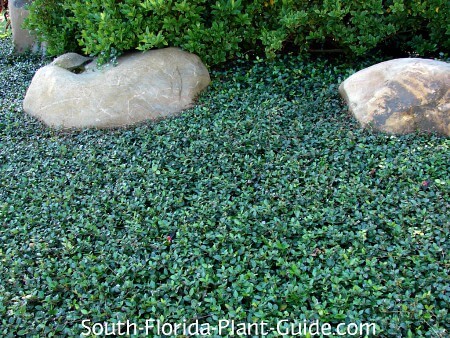
These plants do require routine maintenance – keeping the planting area edged and snipping off an occasional wayward shoot that tries to climb.
But other than that, this is an easy-care groundcover, and makes an excellent turf grass replacement for areas where grass doesn’t do well, such as under the shade of tree canopies.
This groundcover can take a while to completely cover an area so you may have to weed in between plants. After Asiatic jasmine is mature, it tends to win the war against weeds.
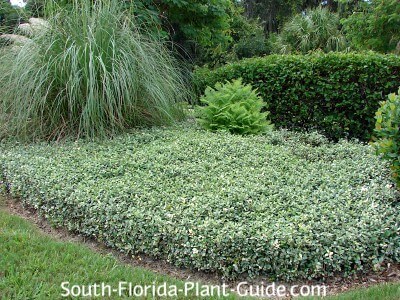
Though it’s most commonly used in formal landscaping, Asiatic jasmine adds a touch of class to a casual landscape and looks very elegant in a woodland setting.
This plant is usually seen with deep green glossy leaves, but variegated varieties are available.
Plant specs
These plants are cold hardy and do well everywhere in South Florida.
They’re moderate growers that start out somewhat slow and then speed up the growth rate as they become established.
This groundcover takes any kind of light, but seems to do best in part sun to dappled shade.
A newer cultivar called ‘Summer Sunset’ (pictured below) thrives in sun and can turn an all-green landscape into a showplace.
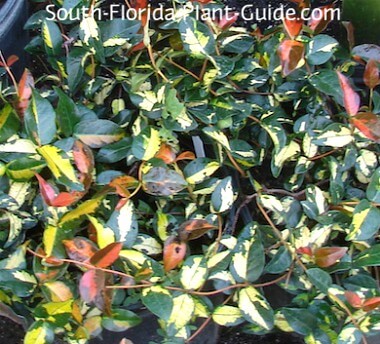
Another showy variety called ‘Snowcap’ (pictured below) is best in shade or morning sun only.
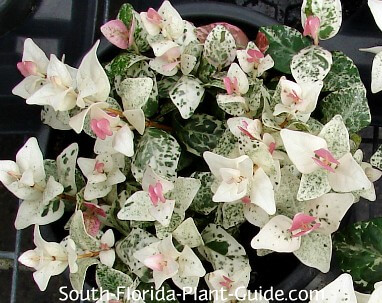
Plant care
Add a mixture of composted cow manure and top soil to the hole when planting.
Keep the area edged so the groundcover stays in bounds and grows back over itself to form a thick mat.
You can mow over it once a year in early spring (mid March) with the mower blade set high (4 inches). This keeps the height more uniform.
Or use a weedwhacker to trim for a level look, but avoid whacking the tree trunk or base of any plant it surrounds.
Water on a regular basis but allow time between waterings for the soil to go dry. Don’t plant in a shaded area that stays moist.
Fertilize 2 times a year – in spring and late summer – with a good controlled release fertilizer.
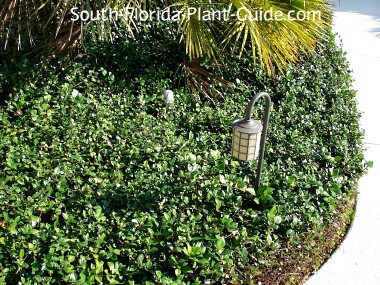
Plant spacing
Mass plantings of this jasmine groundcover will give the best effect. Place 4″ pots about a foot apart, 1 gallon pots about 18 inches apart.
You can grow this plant in a container.
A.K.A. (also known as): Jasmine Minima, Dwarf Jasmine
GOOD SNOWBIRD PLANT? YES
COMPANION PLANT SUGGESTIONS: These low growing groundcover plants do their best work surrounding a tree. They can also front a hedge like podocarpus or a foundation plant like Indian hawthorne. Or use them around a specimen plant such as windmill palm, king sago, strawberry guava, or weeping hibiscus tree.
Asiatic Jasmine
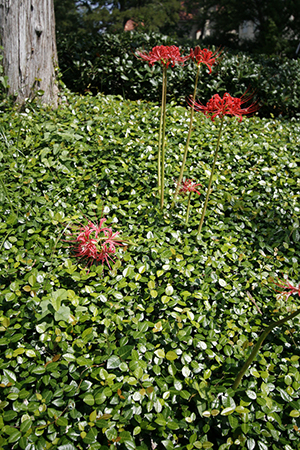
Asiatic jasmine is an evergreen, vine-like woody plant that is commonly used in Florida landscapes due to its hardiness and drought tolerance. Native to Japan and Korea, Trachelospermum asiaticum is a low maintenance groundcover that is great for mass plantings and turfgrass alternatives. It’s an ideal plant for people who want an attractive garden without all the hard work. In shady areas, it also provides needed texture and variation.
Characteristics
Despite the name, this plant is not related to the common jasmine plant. This climbing groundcover has small, dark green, leathery leaves with brownish-red vines. The vines slowly extend across the ground and create a dense, tangled blanket. The leaves grow in opposite pairs and are between 1-2 inches in length.
The plant will grow to at least 3 feet wide and between 6 and 18 inches tall. Asiatic jasmine has small pinwheel-shaped yellow flowers, but rarely blooms in Florida.
Once established, Asiatic jasmine requires very little maintenance to keep it looking nice. Most people use this groundcover where turfgrass won’t grow, as Asiatic jasmine will tolerate many growing conditions and suppresses weed growth.
Asiatic jasmine requires little mowing, but edges should be trimmed occasionally. It should be used in low traffic areas, as it doesn’t withstand foot traffic well. This plant is easier to control when neglected. Too much water, sun, or fertilizer can make it aggressive and unruly.
Asiatic jasmine is salt tolerant and can be grown in coastal areas. This versatile plant can even be grown in containers and hanging baskets.
Planting and Care
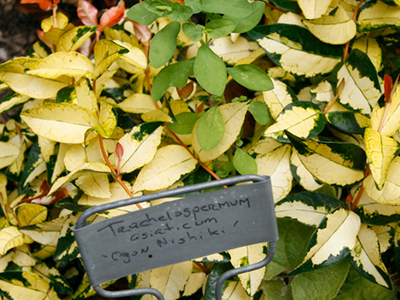
An unusual variety of Asiatic jasmine called Ogon Nishiki, photograhed at Joy Creek Nursery in Oregon.
Asiatic jasmine requires little upkeep and will keep its beauty throughout the year. These plants are usually purchased as transplants and should be started on clear, weed-free soil.
Plants should be placed one and a half feet apart and will take two growing seasons to fill in completely. This plant will tolerate many soils, but prefers well-draining, moist soil when first planted. Once established it is drought tolerant and extremely hardy.
The plant needs little watering; with regular rainfall, extra irrigation is rarely needed. A slow-feeding fertilizer should only be applied three to four times a year for the first year, after that fertilizer should only be applied once a year in the spring when the plant is actively growing.
Asiatic jasmine should be mowed and pruned once a year in the spring to keep an attractive appearance and reduce the risk for diseases; it will also keep it controlled.
Asiatic jasmine can be grown in all areas of Florida, as it can handle cold temperatures as well as very hot ones. This plant will grow well in both dense shade and full sun, and has very few pest, disease and weed problems.
For more information on Asiatic jasmine, contact your county Extension office.